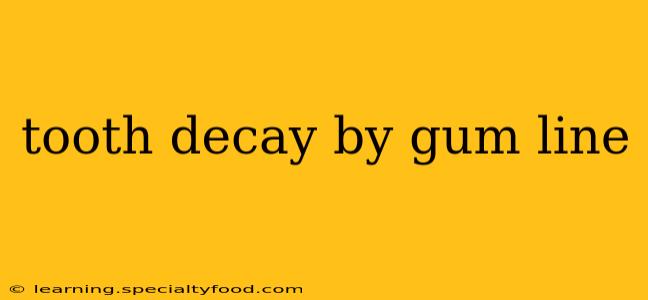Tooth decay, or dental caries, can occur anywhere on the tooth, including the gum line. This area is particularly vulnerable due to its unique anatomy and susceptibility to various factors. Understanding the causes, symptoms, and treatment options for gum line decay is crucial for maintaining optimal oral health.
What Causes Tooth Decay at the Gum Line?
Several factors contribute to the development of tooth decay near the gum line. These include:
-
Plaque Buildup: Plaque, a sticky film of bacteria, constantly forms on teeth. If not removed through brushing and flossing, it produces acids that attack tooth enamel, leading to decay. The gum line is a common area for plaque accumulation because it's harder to reach effectively.
-
Receding Gums: As gums recede, more of the tooth root becomes exposed. Root surfaces are less resistant to decay than enamel because they contain less mineral content. This makes them highly susceptible to acid erosion from plaque.
-
Inadequate Oral Hygiene: Insufficient brushing and flossing allow plaque and food particles to linger at the gum line, providing an ideal environment for bacterial growth and acid production.
-
Diet: A diet high in sugary and acidic foods and drinks contributes significantly to the development of cavities. These substances feed the bacteria in plaque, accelerating the decay process.
-
Dry Mouth: Saliva helps neutralize acids and wash away food particles. Individuals with dry mouth (xerostomia), often caused by medications or medical conditions, are at increased risk of gum line decay because of reduced salivary flow.
-
Poorly Fitting Dental Restorations: If fillings, crowns, or other dental restorations are poorly placed, they can create gaps where bacteria can accumulate and cause decay.
What are the Symptoms of Tooth Decay at the Gum Line?
Early gum line decay may not exhibit noticeable symptoms. However, as the decay progresses, you may experience:
-
Sensitivity to Hot and Cold: This is often an early sign, indicating damage to the dentin (the layer beneath the enamel).
-
Discomfort or Pain: As decay penetrates deeper into the tooth, it may cause throbbing pain, especially when chewing or biting.
-
Visible Cavities: In more advanced stages, a dark spot or hole may be visible at the gum line.
-
Bad Breath: Decaying tooth material can contribute to persistent bad breath (halitosis).
-
Swelling or Redness of the Gums: Inflammation of the gums around the affected area may occur.
How is Tooth Decay at the Gum Line Treated?
Treatment for gum line decay depends on the severity of the decay:
-
Fluoride Treatments: Professional fluoride applications can help strengthen tooth enamel and make it more resistant to acid attacks.
-
Fillings: Small cavities can often be repaired with fillings made from composite resin, amalgam (silver), or gold.
-
Crowns: For larger cavities or extensively damaged teeth, a crown may be necessary to restore the tooth's structure and function.
-
Root Canal Treatment: If the decay reaches the pulp (the soft tissue inside the tooth), a root canal may be needed to remove the infected pulp and save the tooth.
-
Extraction: In cases of severe decay where the tooth is beyond repair, extraction may be the only option.
Can Gum Line Decay Be Prevented?
Yes, gum line decay is largely preventable through diligent oral hygiene and regular dental checkups. Here's how:
-
Brush and Floss Regularly: Brush your teeth twice a day with fluoride toothpaste and floss at least once daily to remove plaque and food particles from the gum line.
-
Maintain a Healthy Diet: Limit your intake of sugary and acidic foods and drinks.
-
Use Fluoride Mouthwash: Fluoride mouthwash can provide extra protection against decay.
-
Regular Dental Checkups: Visit your dentist for regular checkups and cleanings, typically every six months. Early detection and treatment of gum line decay are essential for preventing more extensive damage and potential complications.
What if I have Receding Gums and Decay?
Receding gums increase your susceptibility to gum line decay. Your dentist can assess the severity of the gum recession and recommend appropriate treatment, which may include deep cleaning, gum grafts, or other procedures to help preserve the remaining gum tissue and prevent further decay.
How can I tell if it's just staining or decay at my gum line?
It can be difficult to distinguish between staining and decay. Only a dentist can accurately diagnose the problem. If you notice any discoloration, sensitivity, or pain at your gum line, it's crucial to schedule an appointment for a professional examination.
Is gum line decay more common in adults or children?
While gum line decay can affect people of all ages, it's more common in adults due to factors like receding gums, longer exposure to dietary sugars and acids, and potentially less meticulous oral hygiene habits. However, children are also susceptible, particularly if they consume sugary drinks or foods frequently.
This information is for general knowledge and does not constitute medical advice. Always consult with a dental professional for diagnosis and treatment of any oral health concerns.
